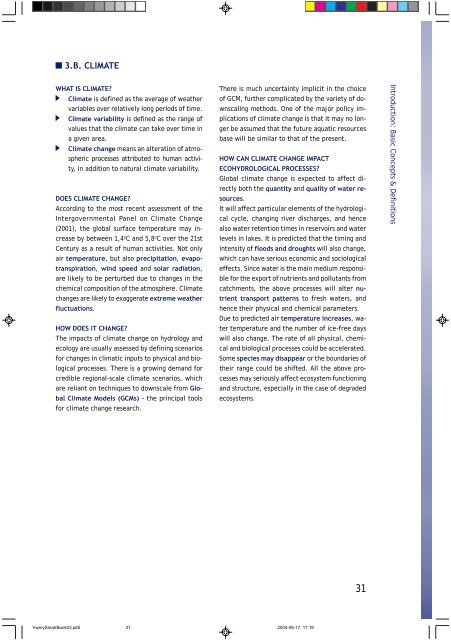Manual - International Environmental Technology Centre
Manual - International Environmental Technology Centre
Manual - International Environmental Technology Centre
You also want an ePaper? Increase the reach of your titles
YUMPU automatically turns print PDFs into web optimized ePapers that Google loves.
3.B. CLIMATE<br />
WHAT IS CLIMATE?<br />
Climate is defined as the average of weather<br />
variables over relatively long periods of time.<br />
Climate variability is defined as the range of<br />
values that the climate can take over time in<br />
a given area.<br />
Climate change means an alteration of atmospheric<br />
processes attributed to human activity,<br />
in addition to natural climate variability.<br />
DOES CLIMATE CHANGE?<br />
According to the most recent assessment of the<br />
Intergovernmental Panel on Climate Change<br />
(2001), the global surface temperature may increase<br />
by between 1,4oC and 5,8oC over the 21st<br />
Century as a result of human activities. Not only<br />
air temperature, but also precipitation, evapotranspiration,<br />
wind speed and solar radiation,<br />
are likely to be perturbed due to changes in the<br />
chemical composition of the atmosphere. Climate<br />
changes are likely to exaggerate extreme weather<br />
fluctuations.<br />
HOW DOES IT CHANGE?<br />
The impacts of climate change on hydrology and<br />
ecology are usually assessed by defining scenarios<br />
for changes in climatic inputs to physical and biological<br />
processes. There is a growing demand for<br />
credible regional-scale climate scenarios, which<br />
are reliant on techniques to downscale from Global<br />
Climate Models (GCMs) - the principal tools<br />
for climate change research.<br />
There is much uncertainty implicit in the choice<br />
of GCM, further complicated by the variety of downscaling<br />
methods. One of the major policy implications<br />
of climate change is that it may no longer<br />
be assumed that the future aquatic resources<br />
base will be similar to that of the present.<br />
HOW CAN CLIMATE CHANGE IMPACT<br />
ECOHYDROLOGICAL PROCESSES?<br />
Global climate change is expected to affect directly<br />
both the quantity and quality of water resources.<br />
It will affect particular elements of the hydrological<br />
cycle, changing river discharges, and hence<br />
also water retention times in reservoirs and water<br />
levels in lakes. It is predicted that the timing and<br />
intensity of floods and droughts will also change,<br />
which can have serious economic and sociological<br />
effects. Since water is the main medium responsible<br />
for the export of nutrients and pollutants from<br />
catchments, the above processes will alter nutrient<br />
transport patterns to fresh waters, and<br />
hence their physical and chemical parameters.<br />
Due to predicted air temperature increases, water<br />
temperature and the number of ice-free days<br />
will also change. The rate of all physical, chemical<br />
and biological processes could be accelerated.<br />
Some species may disappear or the boundaries of<br />
their range could be shifted. All the above processes<br />
may seriously affect ecosystem functioning<br />
and structure, especially in the case of degraded<br />
ecosystems.<br />
VwerySmatrBook03.p65 31<br />
2004-06-17, 17:18<br />
31<br />
Introduction: Basic Concepts & Definitions

















